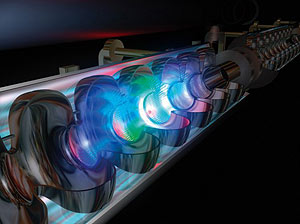Ru
|
Eng
Belarusian components for International Linear Collider
18.12.2014

For the first time ever Belarusian scientists have created a superconducting niobium resonator, which is the key component of acceleration sections of the International Linear Collider (ILC), the press service of the Belarusian State University (BSU) told BelTA.
“For the first time ever a superconducting niobium resonator for accelerators of electrons and positrons with the loaded quality factor of 1.49x10 to the power of nine has been created in Belarus. No one else in the world has managed to achieve such results. The resonator is the key component of acceleration sections of the International Linear Collider,” explained the BSU press service.
The superconducting niobium resonator is one of the components of the International Linear Collider where the energy of electromagnetic field is transferred to charged particles, which are being accelerated. About 20,000 resonators of the kind will be required to build the linear collider and Belarus may become one of the manufacturers.
Research divisions of Belarus’ three top research institutions — the Belarusian State University, the Belarusian State University of Informatics and Radioelectronics, and the National Academy of Sciences of Belarus — were involved in implementing the project. Cooperation with the world’s leading centers that have the technology to make and test niobium resonators was established as part of the project.
The International Linear Collider is expected to become the next step in studying high-energy physics after the Large Hadron Collider (LHC). The International Linear Collider is a complicated machine that will be dozens of kilometers long. It will be able to accelerate charged elementary particles to sublight speeds using high-frequency electromagnetic field. The International Linear Collider will be used in an effort to understand what the Universe is made of and how its constituent parts interact with each other. The collider is expected to be built in Japan. As much as $7.8 billion will be required for the project or nearly twice as much as the cost of the project to create the largest collider to date — the 27km Large Hadron Collider (LHC).
“For the first time ever a superconducting niobium resonator for accelerators of electrons and positrons with the loaded quality factor of 1.49x10 to the power of nine has been created in Belarus. No one else in the world has managed to achieve such results. The resonator is the key component of acceleration sections of the International Linear Collider,” explained the BSU press service.
The superconducting niobium resonator is one of the components of the International Linear Collider where the energy of electromagnetic field is transferred to charged particles, which are being accelerated. About 20,000 resonators of the kind will be required to build the linear collider and Belarus may become one of the manufacturers.
Research divisions of Belarus’ three top research institutions — the Belarusian State University, the Belarusian State University of Informatics and Radioelectronics, and the National Academy of Sciences of Belarus — were involved in implementing the project. Cooperation with the world’s leading centers that have the technology to make and test niobium resonators was established as part of the project.
The International Linear Collider is expected to become the next step in studying high-energy physics after the Large Hadron Collider (LHC). The International Linear Collider is a complicated machine that will be dozens of kilometers long. It will be able to accelerate charged elementary particles to sublight speeds using high-frequency electromagnetic field. The International Linear Collider will be used in an effort to understand what the Universe is made of and how its constituent parts interact with each other. The collider is expected to be built in Japan. As much as $7.8 billion will be required for the project or nearly twice as much as the cost of the project to create the largest collider to date — the 27km Large Hadron Collider (LHC).
SCIENCE. TECHNOLOGY. INNOVATIONS
13.08.2024
28.06.2024
28.06.2024
25.06.2024
05.06.2024
15.05.2024
15.05.2024
26.04.2024
26.04.2024
26.04.2024













